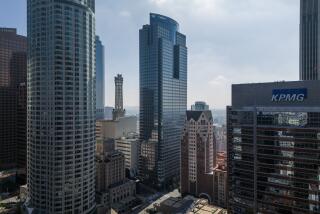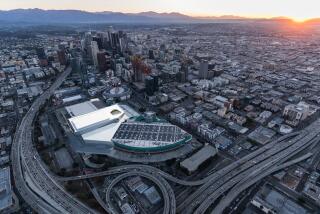Experts’ goal: To make buildings terror-proof
A week before the Sept. 11 terrorist attacks on the World Trade Center, structural engineers met at a conference in Frankfurt, Germany, and wondered aloud about how to build taller skyscrapers.
Today, they will join architects and other building experts in Chicago for a far more sober discussion: Will such high-profile symbols of power and prestige be built any time soon -- and, if so, what can be done to make them safer and more secure?
Chicago is an appropriate choice for debating these issues, and not just because the city is home to Sears Tower, the nation’s tallest building.
Even as others argue that supertall buildings will forevermore be prime terrorist targets, New York City developer Donald Trump is still planning a Chicago office-condominium tower that could rise as high as 1,300 feet -- only about 65 feet shorter than the destroyed trade center towers.
But no U.S. developer, not even one as successful as Trump, will be able to get financing for such a prominent skyscraper today, predicts Eugene Kohn, a partner in the New York City architectural firm of Kohn Pedersen Fox.
“There is an emotional reaction to the tall building,” Kohn says, citing World Trade Center survivors who have told him they have no desire to work again in a high-rise.
Kohn will be among the experts prognosticating the future of the skyscraper Monday as the Council on Tall Buildings and Urban Habitat, an international group of architects, engineers and other building experts based at Lehigh University in Bethlehem, Pa., holds an all-day session on the skyscraper’s future.
To gauge the sentiments of the experts speaking at the meeting, to be held at O’Hare International Airport, the Tribune interviewed several of them beforehand. Some, like Kohn, say it could be a decade before another supertall tower is built in the U.S. Others, like Trump’s architect, Adrian Smith of Skidmore, Owings & Merrill, forecast that such a project could get under way in just two or three years.
Yet in light of the World Trade Center’s stunning collapse, all the experts agreed, it would be wise to rethink the design and construction of skyscrapers, especially those that top 1,000 feet and are therefore considered supertall.
“Whenever a building falls down, there’s a lesson to be learned,” says William Baker, a structural engineer at Skidmore, Owings & Merrill and a member of an engineering team that is studying the New York City disaster.
Citing examples in Europe and Asia, the architects and engineers suggested everything from wider fire stairs that will enable people to get out of buildings more quickly to “refuge floors,” heavily fireproofed floors where people can gather below a fire.
Skyscrapers might be equipped with special elevators for firefighters, they said, while underground parking garages at skyscrapers could be banned, eliminating a spot from which terrorists can strike. New structural techniques, such as heavyweight concrete cores, also might save lives.
The big question underlying all the proposals is whether a new set of assumptions -- and thus, a new set of building codes -- should govern the design of supertall skyscrapers.
Currently, codes assume emergency conditions requiring escape from a fire confined to one or two floors of a skyscraper. Now, should codes reflect the danger posed by the much larger fires and structural damage that results when a jetliner hits a building? Or was Sept. 11 a one-time event?
Everything depends, Smith says, “on whether you are planning for a terrorist attack. If you’re planning for that, then there are a whole host of things you have to do.”
Many of the experts said it would be foolish to place too much responsibility on building design and management, because the chief cause of the World Trade Center’s collapse was the hijacking of two jetliners and the transformation of those planes into flying bombs.
“I think security has to start on the airplane,” says Thomas Fridstein, director of design for the New York-based developer and building owner Tishman Speyer.
Above all, the experts are warning people against overreacting. Historically, they say, skyscrapers have been very safe places, with only a small number of deaths resulting from fires and structural collapses.
Moreover, they point out, the U.S. has only eight supertall buildings to worry about: Sears Tower, the John Hancock Center and the Aon Center (the former Amoco Building) in Chicago; the Empire State and Chrysler Buildings in New York; and one supertall tower each in Los Angeles, Houston and Atlanta. And some of these skyscrapers seem to be unlikely targets.
The Golden Gate Bridge is a more tempting structure for terrorists than the 1,018-foot Library Tower (the former First Interstate World Tower) in Los Angeles, said L.A. architect Richard Keating. Indeed, Keating and his wife recently decided to move their design practice to the tower’s 57th floor.
“I don’t feel (that what happened Sept. 11) was an attack against people; it was an attack against symbols,” Keating said. In the wake of the Sept. 11 attacks, some doomsayers, who consider the skyscraper overscaled and inhumane, such as the author James Kuntsler, have predicted the end of the skyscraper, but in Asian countries, including China, skyscraper construction goes on. Indeed, Chinese authorities have announced that the planned World Financial Center will be even taller than originally planned, topping 1,500 feet, which would make it the world’s tallest building.
Practical projects
In addition to such symbolic statements, the experts said, there remain practical reasons for building skyscrapers: They create high-density environments that work well with mass transit, and they save energy. High land values mean that builders have to build upward, rather than outward. And even in the age of the Internet and cell phones, businesses still depend on face-to-face contact that skyscrapers permit.
“In the long run, people will return to the tall building,” Kohn says. “Once the marketplace permits it, the supertall buildings will be built in the United States, though it may be a decade.”
What, if anything, might be different when they do return?
One thing that is sure to change is the way such buildings are built. In contrast to the nearly 30-year-old World Trade Center towers, which were chiefly supported by closely-spaced exterior steel columns that engineers call a “tube,” the latest supertall structures in Asia are held up by a more economical system consisting of a concrete core, several feet thick, and perimeter “supercolumns” that provide additional stability. (The world’s tallest buildings, the Petronas Twin Towers in Malaysia, use this system.)
Such cores, some of the experts say, might have better resisted the force of a hijacked plane. That way, the buildings would have stood up longer and people would have had more time to get out.
“This new generation of tall buildings already was heading in a different direction,” says Joseph Burns of the Chicago office of Thornton-Tomasetti Engineers, which was invited to the conference but won’t be able to attend. “If properly detailed, they might perform better than the World Trade Center.”
American developers and building owners might learn other lessons from the latest generation of supertall towers that have been built in Asia, the experts say.
For example, many of these buildings are equipped with so-called refuge floors, where people can gather below a fire and, if necessary, be marshaled into lines to exit the building. These heavily fortified floors are also designed to stop fires from spreading through a building.
In addition, some Asian skyscrapers have elevators that are reserved exclusively for firefighters. Such elevators, which occupy pressurized shafts that keep smoke out, allow firefighters to reach a blaze quickly.
Yet there is a potential problem with these steps and with calls for wider fire escapes, which would be located at the bottom of a building, where the largest crowds of fleeing office workers accumulate: They chew up rentable floor area -- the skyscraper’s economic reason for being.
Special precautions
Developers and buildings owners “are going to be unhappy,” Kohn says. But he adds, “if you assume there’s going to be another tragedy of this magnitude, then special precautions would need to be taken to make these (tenants) feel comfortable.”
Many building owners already have adopted such steps in Europe and Asia, said Fridstein, pointing to lobby security checkpoints that are used in London and other cities. Instead of going directly to an elevator, visitors must check in at a security desk, wait for a security guard to call upstairs, then pass through a turnstile.
Increasingly, that’s becoming the norm in the U.S. “We’ve just awakened,” Fridstein says, “to the fact that life isn’t as casual as it used to be.”
More to Read
Sign up for Essential California
The most important California stories and recommendations in your inbox every morning.
You may occasionally receive promotional content from the Los Angeles Times.









